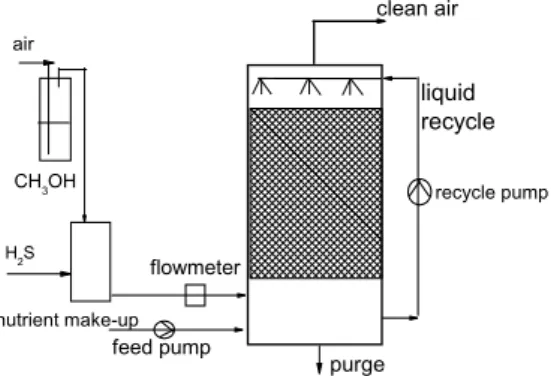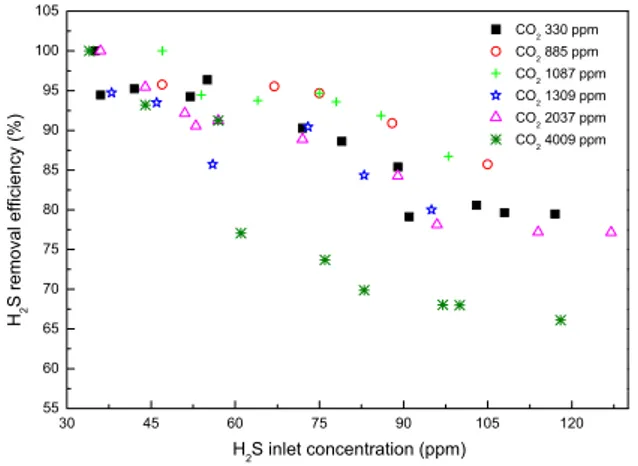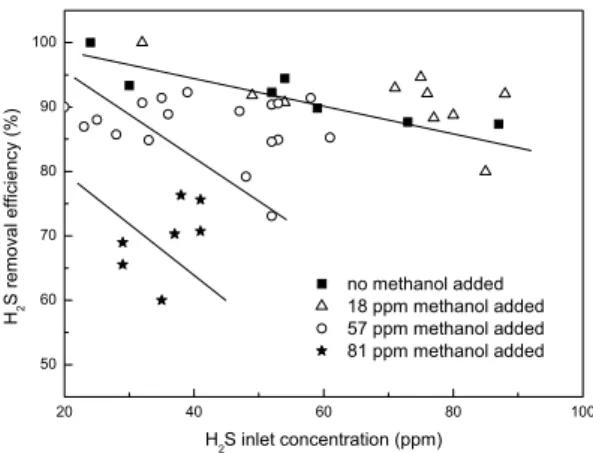TítuloEffects of CO2 and methanol on the degradation of hydrogen sulfide in a biotrickling filter
Texto completo
(2) 78. Y. JIN, M. C. VEIGA AND C. KENNES. conventional technologies for the treatment of low-concentration polluted air streams (Devinny et al., 1999; Kennes and Thalasso, 1998; Kennes and Veiga, 2001). The biological removal of H2S has been studied by a number of researchers, mainly under heterotrophic conditions in presence of organic carbon substrates (Jin et al., 2005a). However, hardly any reports have been published on the autotrophic removal of H2S from polluted air, nor on the effects of process conditions as CO2 concentration on its efficiency. The heterotrophic removal of H2S from polluted air requires the presence of an external organic carbon source which may sometimes be available, for example when treating waste air from wastewater treatment plants and using such wastewater as trickling phase. Nevertheless, whenever an external carbon source is not directly available, the autotrophic removal of H2S will be cheaper and more advantageous since it is based on the use of CO2 from air as a carbon source. Another advantage of fomenting the activity of autotrophic rather than heterotrophic biocatalysts is that the slower biomass growth and build-up of the former will avoid clogging problems, quite typical in heterotrophic systems. Autotrophs are also interesting because of their low nutritional requirements. It is interesting to note that autotrophic microorganisms do not produce any CO2 as happens with heterotrophs. Since they fix CO2 during the removal of H2S, the CO2 concentration could presumably have an influence on the biodegradation rate of H2S and the bacteria’s growth rate. H2S and CO2 may coexist in a variety of polluted gas streams, e.g. pressurized natural gas, synthesis gas, biogas, as well as polluted air released from wastewater treatment plants, pulp and paper industries, or refineries. Different authors (Haddadin et al., 1993; Torma et al., 1972) mentioned the influence of carbon dioxide on bacterial growth, biomass concentration as well as on the rate of sulfide oxidation. They suggest that the CO2 concentration may play an important role in sulfide biooxidation. Therefore, the effect of CO2 on the removal efficiency of H2S may provide important information to develop efficient biotechnological processes for field application. To date, most lab-scale biofiltration studies address the removal of single pollutants under constant operating conditions. Such conditions are highly unusual at wastewater treatment plants and other facilities. For instance, the waste gas of paper and pulp industry is a complex mixture of H2S and other reduced sulfur compounds (such as dimethyl sulfide, dimethyl disulfide, and methyl mercaptan), as well as volatile organic compounds (such as methanol, terpenes, alcohols, phenol, ketones, and formaldehyde. The actual composition and individual concentrations often vary substantially over time. Since the co-treatment of H2S and VOCs in biotrickling filters is a relatively unexplored area, and autotrophic microorganisms do not use methanol (CH3OH) as a carbon source for growth, the simultaneous biotreatment of H2S and CH3OH was investigated in this study. H2S and methanol are two major air pollutants of industries such as the pulp and paper industries. CH3OH is a volatile organic compound commonly used in industry, which may have harmful effects on human health. Therefore, it has been listed as one of the 189 Hazardous Air Pollutants included in the 1990 Clean Air Amendment list in the US. Even though it may also have negative effects on microorganisms, different studies have proved that methanol can effectively be removed at rates up to 280 g.m-3.h-1 from air by means of bioreactors (Prado et al., 2005). The objective of this study is to assess the impact of CO2, and the cotreatment of waste gases containing a mixture of H2S and CH3OH in an autotrophic biotrickling filter..
(3) EFFECTS OF CO2 AND METHANOL ON THE AUTOTROPHIC DEGRADATION OF HYDROGEN SULFIDE IN A …. 79. 2 MATERIALS AND METHODS 2.1 Microorganisms and cultivation An autotrophic H2S-degrading culture obtained from the activated sludge of the fullscale wastewater treatment plant of a resin-producing industry was enriched in a biofilter. The characteristics of the sludge have been described elsewhere (Prado et al., 2004). The biomass was acclimized to sulfur compounds in a sodium thiosulphate mineral medium without addition of any external organic carbon source. The composition of the liquid medium used was (in g.l-1): KH2PO4, 2; K2HPO4, 2; NH4Cl, 0.4; MgCl2.6H2O, 0.2; FeSO4.7H2O, 0.01; and Na2S2O3.5H2O, 8 (Jin et al., 2005a). 2.2 Experimental setup The schematic of the biotrickling filter used in this study is shown in Figure 1 and has been described previously in detail (Jin et al., 2005a). It is a cylindrical packed bed reactor made of glass, 75 mm in diameter and 700 mm in height. The packed column was filled with polypropylene Pall rings of a nominal height of 15 mm. The total height of the packed bed was 640 mm. The Pall ring bed had an initial porosity of 91% and a specific surface area of 350 m2.m-3. The glass column contained four equidistant sampling ports. All fittings, connections and tubings were made of Teflon. H2S was introduced by passing the air stream over a H2SO4 solution into which a solution of Na2S was dripped. Gas phase H2S concentrations ranging from 0 to 190 ppm were obtained by changing the Na2S concentration and/or dripping rate. The resulting synthetic waste gas was introduced through the bottom of the column for countercurrent flow operation. Initially, the gas flow rate was maintained constant at 7 L.min-1, corresponding to an empty bed residence time of 24 s. The aqueous mineral medium described above, without Na2S2O3 nor any external carbon source, was continuously recirculated over the packed bed using a peristaltic pump (model 323E/D, WatsonMarlow Limited, Falmouth Cornwall, England) at a constant volumetric flow rate of 2.77 L.h-1. The nutrient solution of the biotrickling filter was renewed every day. During the experimental study on the effect of CO2, carbon dioxide from a gas cylinder flew first through a pressure gauge (RBDE-30/PS-3.5, Carburos Metalicos S.A., La Coruña, Spain) and then through a flowmeter (Model VCD 1000 flow controller, Porter Instrument Co., Inc., Hatfield, PA, USA) in order to reach the expected CO2 concentration in the inlet gas. During the experiment on the CH3OH effect, CH3OH was. clean air air. liquid recycle CH3OH. recycle pump. H2S. flowmeter. nutrient make-up. feed pump. purge. Figure 1. Schematic of the laboratory scale biotrickling filter..
(4) 80. Y. JIN, M. C. VEIGA AND C. KENNES. introduced into the gas stream by feeding a side air stream through a bottle filled with pure CH3OH (Figure 1). 2.3 Analytical methods Inlet and outlet H2S concentrations were determined using a gas sensor (Dräger Sensor XSEC H2S HC6809180). Methanol concentration was measured by means of a HP6890 gas chromatograph (Agilent T., Spain) equipped with a 30 m×0.53 mm HP-PLOT Q column and a flame ionization detector, operating in splitless mode. Oven temperature was 130 °C, while both the injector and detector temperature was 150 °C. Samples were injected using a 2.5 cm3 gas-tight Hamilton syringe. Under these conditions, the retention time of methanol was 3.5 min (Prado et al., 2005). Similarly, CO2 concentrations were measured on another Hewlett-Packard 5890 series II GC equipped with a thermal conductivity detector (TCD). The CO2 concentrations were determined at an injection temperature of 90 °C, an oven temperature of 25 °C and using a TCD at 100 °C. 3 RESULTS AND DISCUSSION 3.1 Influence of CO2 on performance In this experiment a biotrickling filter was fed H2S-polluted air enriched with different CO2 concentrations. 105 CO2 330 ppm. 100. CO2 885 ppm CO2 1087 ppm. H2S removal efficiency (%). 95. CO2 1309 ppm CO2 2037 ppm. 90. CO2 4009 ppm. 85 80 75 70 65 60 55 30. 45. 60. 75. 90. 105. 120. H2S inlet concentration (ppm). Figure 2. Effect of the CO2 concentration on H2S removal.. According to the data shown in Figure 2, it appeared that in the lower range of H2S concentrations, i.e. <50 ppm, the CO2 concentration had no visible effect on the removal efficiency of H2S. However, a non-negligible enhancement of H2S removal was found when gradually increasing the content of CO2 to 4009 ppm, at H2S concentrations higher than 50 ppm. This indicated that at lower H2S concentrations, the inherent CO2 in the waste gas did not limit the degradation rate, but at high H2S concentrations the pollutant's removal rate was limited by the availability of CO2, probably due to the mass transfer rate of CO2 from the gas phase to the liquid/biofilm. When the CO2 concentration was slightly increased from 865 ppm to 1087 ppm, no detectable.
(5) EFFECTS OF CO2 AND METHANOL ON THE AUTOTROPHIC DEGRADATION OF HYDROGEN SULFIDE IN A …. 81. difference in H2S removal was observed. However, the removal efficiency decreased as the CO2 concentration was further increased to 1309 ppm or more. This means that higher CO2 concentrations can enhance the removal of H2S at CO2 concentrations ranging between ambient levels and 1087 ppm. However, higher concentrations of CO2, e.g. >1309 ppm, did not further improve the degradation of H2S. 3.2 Addition of methanol to a H2S-degrading biotrickling filter Methanol was deliberately supplied in the range of 18 to 81 ppm to allow for the determination of a possible effect (positive or negative) of a carbon source as CH3OH on H2S removal in an originally autotrophic system.. H2S removal efficiency (%). 100. 90. 80. 70. no methanol added 18 ppm methanol added 57 ppm methanol added 81 ppm methanol added. 60. 50 20. 40. 60. 80. 100. H2S inlet concentration (ppm). Figure 3. Influence of methanol on the performance of a biotrickling filter removing H2S.. Figure 3 shows that the removal of H2S was not affected by the addition of 18 ppm of CH3OH. When the CH3OH concentration was increased above this value, from 18 to 81 ppm, a gradual decrease in removal efficiency of H2S was observed as the gas. -1. Elimination capacity. -3. Removal efficiency of methanol (ppm). Removal efficiency 12 80. 9 70 6. 60 3. 50. 10. 20. 30. 40. 50. 60. 70. 80. Elimination capacity of methanol (g.m.h ). 15. 90. 90. 0. Methanol concentration (ppm). Figure 4. Removal efficiency and elimination capacity of CH3OH..
(6) 82. Y. JIN, M. C. VEIGA AND C. KENNES. concentrations of CH3OH increased. The maximum elimination capacity of H2S dropped from 23.82 to 6.42 g H2S.m-3.h-1. This resulted probably to the fact that autotrophic microorganisms were originally dominated in the biofilter, and that they use CO2 as carbon source instead of CH3OH for H2S removal. The presence of CH3OH caused a decrease of the autotrophic activity. Conversely, the elimination capacity of CH3OH did gradually increase from 2.73 to 11 g m-3.h-1 during the same period (Figure 4). This value is much smaller than the maximum elimination capacities reported in the literature, which range from 50-250 g.m-3.h-1 (Sologar et al., 2003). This probably resulted from the pH of the biofilter, around 2, that was not optimum for methanol degradation. The general optimum pH for VOCs degrading microorganisms is usually around 7. On the other hand, only H2S was fed at the beginning and hardly any methanol biodegrading microorganisms were present, which is another reason to explain this phenomenum. The addition of CH3OH allowed the growth of heterotrophs which utilize methanol as carbon source. The removal efficiency of CH3OH did first increase from 58% to 65% and then decreased to 52% at inlet concentrations of CH3OH of 18, 57, and 81 ppm, respectively. 4 CONCLUSIONS The following conclusions can be drawn from the results presented in this study: (1) The CO2 concentration has no significant effect on the BTF's performance in the low range of H2S concentrations, i.e., < 50 ppm. When the H2S concentration is increased above this level, the CO2 concentration seems to improve the BTF's performance at moderate CO2 concentrations, below 1309 ppm. (2) The introduction of CH3OH had no significant influence on H2S removal when the inlet concentration of CH3OH was below 18 ppm. In the range of 57-81 ppm methanol, the removal of H2S was inhibited by the presence of CH3OH. The maximum elimination capacity of H2S dropped from 23.82 to 6.42 g H2S.m-3.h-1. 5 ACKNOWLEDGEMENTS The present research was funded by the Spanish Ministry of Science and Technology (Project PPQ2001-0557). Yaomin Jin was financially supported through a fellowship of the Agencia Española de Cooperación Internacional (AECI) and the Spanish Ministry of Foreign Affairs. 6 REFERENCES Devinny, J.S., Deshusses, M.A. and Webster, T.S. (1999) Biofiltration for air pollution control. Boca Raton: Lewis Publishers. 299 p. Haddadin, J., Morin, D., Ollivier, P. and Fick, M. (1993) Effect of different carbon dioxide concentrations on ferrous iron and pyrite oxidation by a mixed culture of iron and or sulfuroxidizing bacteria. Enzyme Microbial. Technol. 15(10): 832-841. Jin, Y., Veiga, M.C. and Kennes, C. (2005a) Autotrophic deodorization of hydrogen sulfide in a biotrickling filter. J. Chem. Technol. Biotechnol. 80(9): 998-1004. Jin, Y., Veiga, M.C. and Kennes, C. (2005b) Effects of pH, CO2, and flow pattern on the autotrophic degradation of hydrogen sulfide in a biotrickling filter. Biotechnol. Bioeng. (in press). Kennes, C. and Thalasso, F. (1998) Waste gas biotreatment technology. J. Chem. Technol. Biotechnol. 72(4): 303-319..
(7) EFFECTS OF CO2 AND METHANOL ON THE AUTOTROPHIC DEGRADATION OF HYDROGEN SULFIDE IN A …. 83. Kennes, C. and Veiga, M.C. (2001) Bioreactors for waste gas treatment. Kluwer Academic Publishers, Dordrecht, The Netherlands. Prado, O.J., Veiga, M.C. and Kennes, C. (2004) Biofiltration of waste gases containing a mixture of formaldehyde and methanol. Appl. Microbiol. Biotechnol. 65(2): 235-242. Prado, O.J., Veiga, M.C. and Kennes, C. (2005) Treatment of gas-phase methanol in conventional biofilters packed with lava rock. Water Res. 39(11): 2385-2393. Sologar, V.S., Lu, Z. and Allen, G. (2003) Biofiltration of concentrated mixtures of hydrogen sulfide and methanol. Environ. Prog. 22(3): 129-136. Torma, A.E., Walden, C.C., Branion, R.M.R. and Duncan, D.W. (1972) Effect of carbon dioxide and particle surface area on microbiological leaching of a zinc sulfide concentrate. Biotechnol. Bioeng. 14(5): 777-786..
(8)
Figure



Documento similar
Bearing in mind that a change in response style does not imply inconsistency, which may be observed in populations of psychiatric prison inmates, but not in malingerers, nor in
On the other hand, the larvae from 18 ovipostions that were kept in the laboratory at ambient temperatu- re emerged between two and four days after they were collected in the
The Dome of the Rock does attest the existence, at the end of the seventh century, of materials immediately recognisable as Koranic in a text that not infrequently
The faculty may have uploaded some file with the complete timetable by subjects.. 7) Scroll down and click on the academic course. You will find all the classes grouped by
In the “big picture” perspective of the recent years that we have described in Brazil, Spain, Portugal and Puerto Rico there are some similarities and important differences,
Keywords: iPSCs; induced pluripotent stem cells; clinics; clinical trial; drug screening; personalized medicine; regenerative medicine.. The Evolution of
The influence of acidic and alkaline additives was studied on the Pd/C-catalyzed reductive processing of poplar wood in methanol: under acidic (H 3 PO 4 ) conditions
In the preparation of this report, the Venice Commission has relied on the comments of its rapporteurs; its recently adopted Report on Respect for Democracy, Human Rights and the Rule